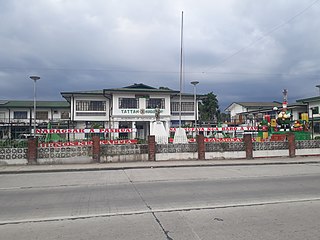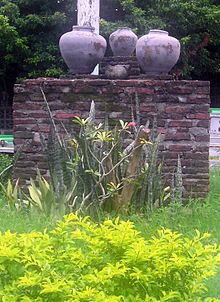
Ilocos Norte, officially the Province of Ilocos Norte, is a province of the Philippines located in the Ilocos Region. Its capital is Laoag City, located in the northwest corner of Luzon Island, bordering Cagayan and Apayao to the east, and Abra to the southeast, and Ilocos Sur to the southwest. Ilocos Norte faces the West Philippine Sea to the west and the Luzon Strait to the north.

Ilocos Sur, officially the Province of Ilocos Sur, is a province in the Philippines located in the Ilocos Region in Luzon. Located on the mouth of the Mestizo River is the capital of Vigan. Ilocos Sur is bordered by Ilocos Norte and Abra to the north, Mountain Province to the east, La Union and Benguet to the south and the South China Sea to the west.

La Union, officially the Province of La Union, is a province in the Philippines located in the Ilocos Region in the island of Luzon. Its capital is the City of San Fernando, which also serves as the regional center of the Ilocos Region.

The Ilocos Region, designated as Region I, is an administrative region of the Philippines. Located in the northwestern section of Luzon, it is bordered by the Cordillera Administrative Region to the east, the Cagayan Valley to the northeast and southeast, Central Luzon to the south, and the South China Sea to the west.

Diego Silang y Andaya was a Filipino revolutionary leader who allied with British forces to overthrow Spanish rule in the northern Philippines and establish an independent Ilocano state. His revolt was fueled by grievances stemming from Spanish taxation and abuses, and by his belief in self-government, that the administration and leadership of the Roman Catholic Church and government in the Ilocos be invested in trained Ilocano officials. His wife, the Itneg Gabriela Cariño, took on leadership of his revolt after his assassination.

San Fernando, officially the City of San Fernando, is a 3rd class component city and capital of the province of La Union, Philippines. According to the 2020 census, it has a population of 125,642 people.

Vigan, officially the City of Vigan, is a 4th class component city and capital of the province of Ilocos Sur, Philippines. According to the 2020 census, it has a population of 53,935 people.

Laoag, officially the City of Laoag, is a 3rd class component city and capital of the province of Ilocos Norte, Philippines. According to the 2020 census, it has a population of 111,651 people.

Sarrat, officially the Municipality of Sarrat, is a 4th class municipality in the province of Ilocos Norte, Philippines. According to the 2020 census, it has a population of 25,186 people.

San Ildefonso, officially the Municipality of San Ildefonso, is a 5th class municipality in the province of Ilocos Sur, Philippines. According to the 2020 census, it has a population of 8,190 people.

Sinait, officially the Municipality of Sinait, is a 3rd class municipality in the province of Ilocos Sur, Philippines. According to the 2020 census, it has a population of 25,998 people.

Naguilian, officially the Municipality of Naguilian, is a 1st class municipality in the province of La Union, Philippines. According to the 2020 census, it has a population of 52,189 people.

The Ilocanos, Ilokanos, or Iloko people are the third largest Filipino ethnolinguistic group. They mostly reside within the Ilocos Region, in the northwestern seaboard of Luzon, Philippines. The native language of the Ilocano people is the Ilocano language.

During the Spanish colonial period in the Philippines (1565–1898), there were several revolts against the Spanish colonial government by indigenous Moro, Lumad, Indios, Chinese (Sangleys), and Insulares, often with the goal of re-establishing the rights and powers that had traditionally belonged to Lumad communities, Maginoo rajah, and Moro datus. Some revolts stemmed from land problems and this was largely the cause of the insurrections that transpired in the agricultural provinces of Batangas, Ilocos sur, Cavite, and Laguna. Natives also rebelled over unjust taxation and forced labor.

The Diocese of Laoag is a Latin Church ecclesiastical jurisdiction or diocese of the Catholic Church in the Philippines.

Philippine wine or Filipino wine are various wines produced in the Philippines. They include indigenous wines fermented from palm sap, rice, job's tears, sugarcane, and honey; as well as modern wines mostly produced from various fruit crops.

Inabel, sometimes referred to as Abel Iloco or simply Abel, is a weaving tradition native to the Ilocano people of Northern Luzon in the Philippines. The textile it produces is sought after in the fashion and interior design industries due to its softness, durability, suitability in tropical climates, and for its austere design patterns.
Kabarawan was a traditional pre-colonial Filipino mead-like alcoholic drink. It was made from boiling the ground up aromatic bark of the kabarawan tree until it was reduced to a thick paste. It was then mixed with an equal amount of honey and fermented. It was traditionally consumed from jars with reed or bamboo straws. The wine was mentioned by early Spanish colonists as being made by the Visayan people. However, the tradition has been lost in modern times. Kabarawan tree bark is also used to flavor other types of native wines, like intus and basi, which are both made from sugarcane juice.
Intus was a traditional pre-colonial Filipino alcoholic drink from the Visayas Islands and Mindanao. It was made by boiling sugarcane juice until it reduces to a thick syrup. It was then allowed to cool and mixed with the bark of the kabarawan tree and fermented. The word intus means "reduced" or "liquid thickened by boiling", from the Old Visayan verb itus. Like the kabarawan drink, intus is extinct. The tradition was lost during the Spanish colonial period of the Philippines. Among the Lumad people of Mindanao, intus was flavored with langkawas or pal-la roots.



















